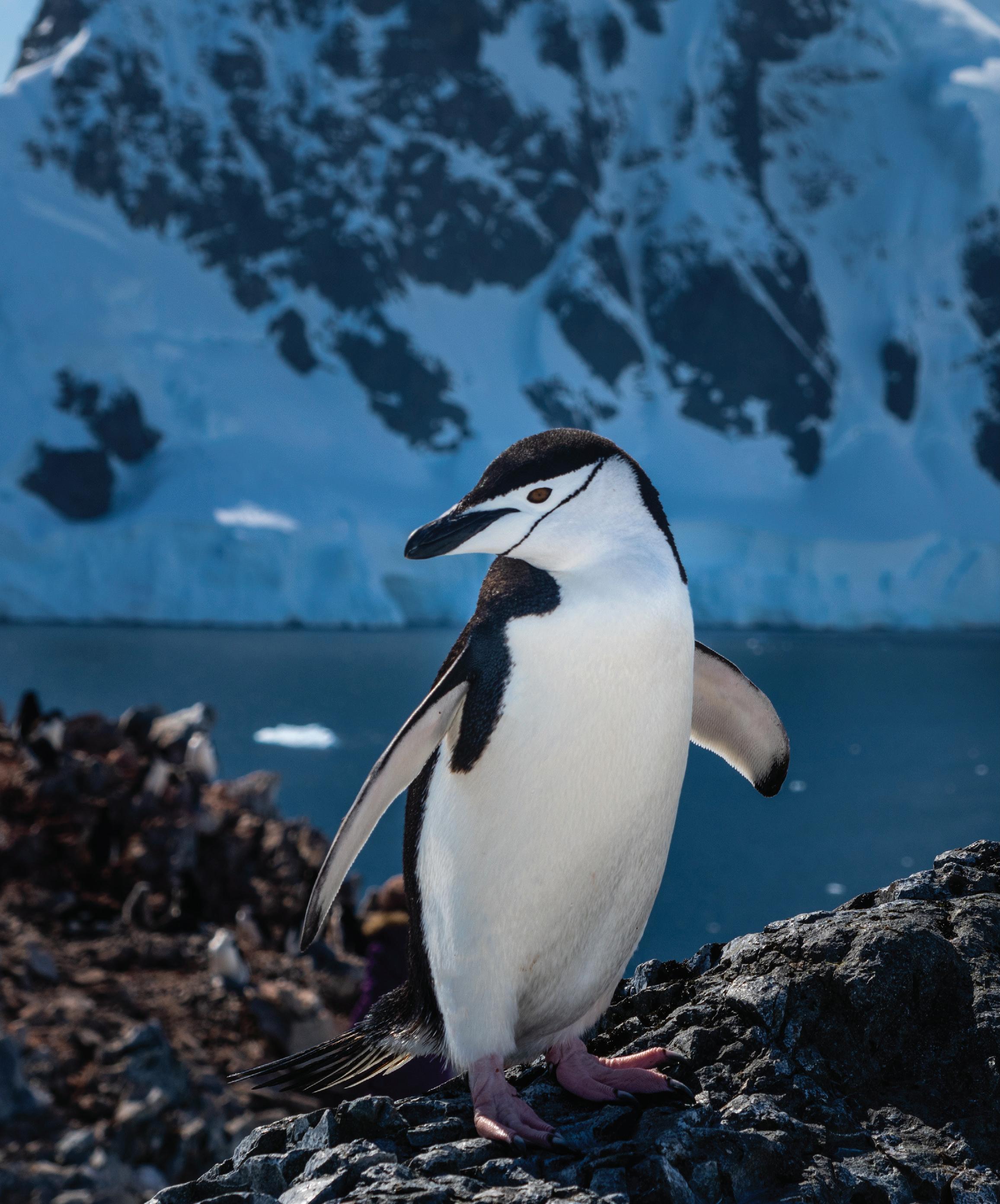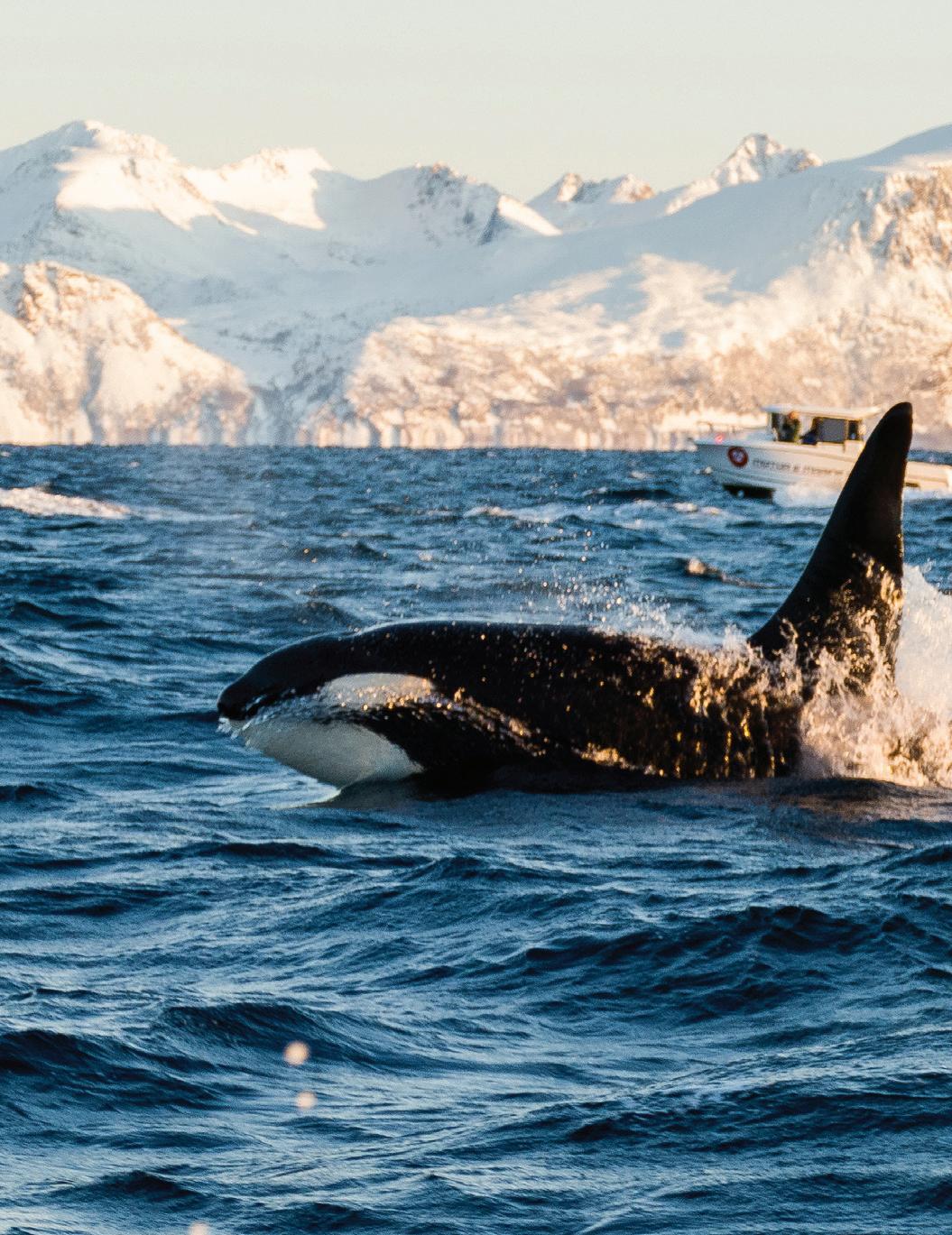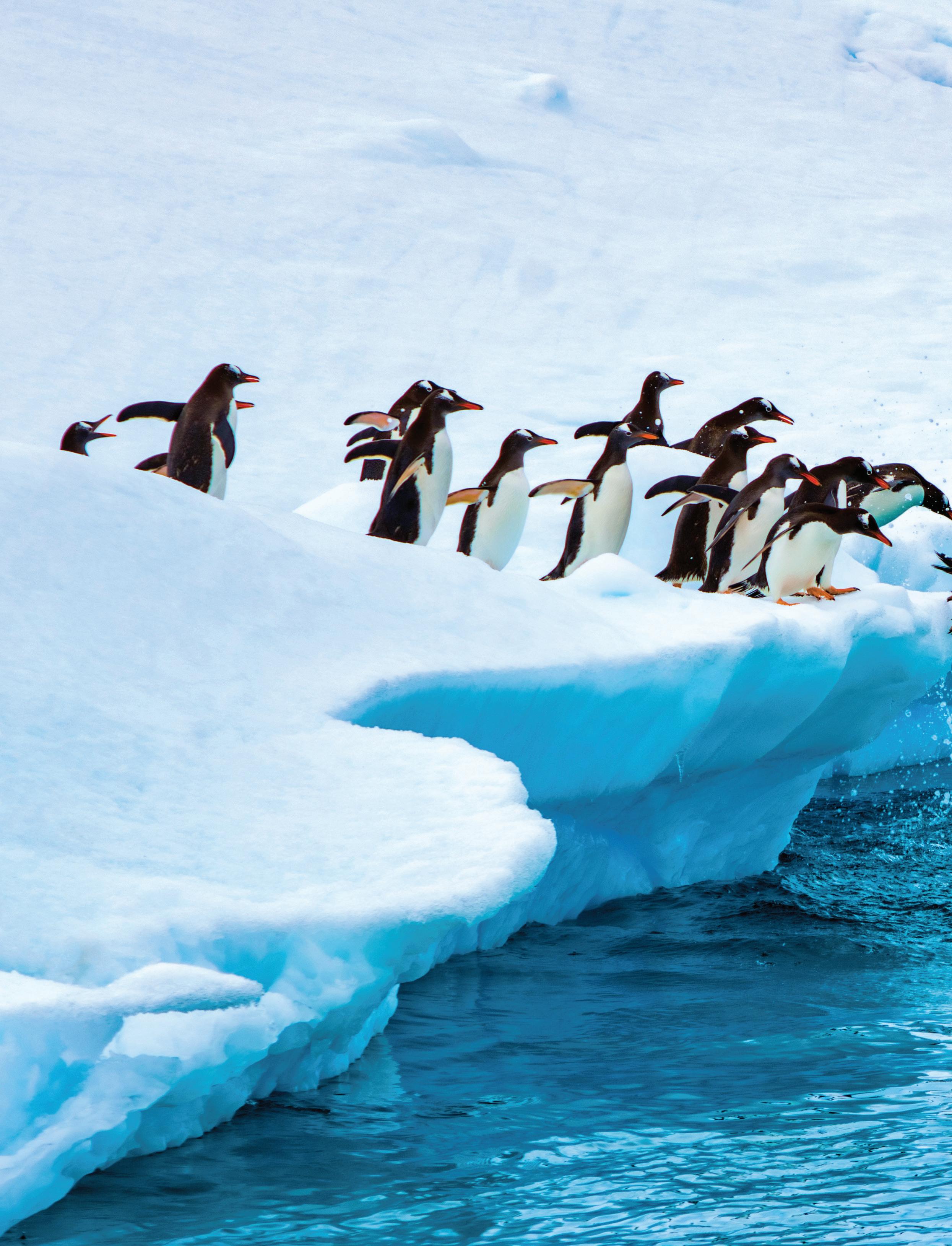
18 minute read
Wildlife



Animals of Antarctica



Despite being one of the coldest, driest and darkest places on Earth, Antarctica is anything but dormant. In this isolated, otherworldly destination where the only resident humans are scientists, diverse wildlife thrives amid the extreme conditions. The White Continent offers animal encounters unlike any other destination, with the likes of gentoo penguins, leopard seals, orcas and albatrosses regularly gracing expedition guests with their presence. Expect to witness penguins sliding on the ice and fur seals lazing in the sun. See migratory birds circling overhead, humpback whales breaching in the wave or orca pods striking coordinated attacks on their prey. The things you see in this wild, remote corner of the globe will live with you long after you return home.

Penguins
Whether it’s playing a starring role in a nature documentary or a blockbuster animation, few are impervious to the charms of a waddling penguin. The opportunity to encounter this beloved flightless bird draws many an expedition cruiser to Antarctica and sightings, virtually guaranteed on every voyage, never fail to awe and entertain. Seven species inhabit Antarctica’s icy waters.


Previous page:
Chinstrap penguin Left to right: Adélie penguins; Gentoo penguin; Emperor penguins; Southern Rockhopper penguin
Adélie Penguins
At around 70cm tall, adélie penguins are one of the smaller penguin species, but what they lack in height they make up for in boisterousness. It’s likely you’ll hear a colony of adélies before you see it, but when you do you can be sure by the white ring surrounding the penguins’ eyes.
Chinstrap Penguins
Chinstrap penguins inhabit the outer islands of the Antarctic Peninsula, where the water is slightly warmer. The sub-Antarctic islands are the summer home of tens of thousands of noisy chinstrap penguins that can be particularly territorial during the breeding season.
Gentoo Penguins
As the third-largest penguin species, gentoo penguins are also one of the most well recognised, with a bright red-orange bill and feet and white blazes above the eyes. Unlike smaller penguin species, gentoo penguins have relatively relaxed natures, and stay with their mate all year round.


Emperor Penguins
The iconic and mighty emperor penguin is the largest of all 18 penguin species on earth, weighing up to 40kg. Utterly unlike other penguins, they are not territorial and rather can be seen huddling in large groups to keep warm. Emperor penguins are the only animals that breed during the Antarctic winter, and can endure temperatures as low as -80º Celsius – the coldest conditions on earth.
Macaroni Penguins
Inhabiting the warmer waters of Antarctica’s surrounding islands, macaroni penguins possess a flamboyant yellow plumage above each eye. Macaronis are skilled swimmers, swimming up to 10,000 kilometres per year.
King Penguins
An iconic sub-Antarctic sighting, the beautiful king penguin’s striking orange markings make it the most brightly coloured penguin species. It can stand up to 100cm tall, and rather than rely on a nest, will carry its egg around on its feet for up to 60 days during the mating season.
Southern Rockhopper Penguins
The petite southern rockhopper penguin is easy to spot with red eyes and a spiky yellow and black plume on the head. Like the star of Happy Feet, Lovelace, this entertaining penguin doesn’t toboggan or belly-slide like other penguins, but rather gets about by hopping and jumping.
Seals
Don’t be surprised if the seals you see on your Antarctic expedition appear unfazed by your presence. Unlike Arctic seals, who share their environment with deadly polar bears, Antarctic seals have few natural predators. These beautiful animals show little fear of humans as a result, making for memorable close encounters and incredible photo opportunities. During breeding season, spot these long-whiskered mammals on the pack ice surrounding Antarctica and in the outlying islands, where up to a million can gather at a time. The six species that inhabit Antarctica make up the vast majority or Earth’s seal population.



Leopard Seals
Like its land-dwelling namesake, the leopard seal is one of Antarctica’s fiercest predators, with spotted, slim bodies designed for speed and razor sharp teeth for catching squid, penguins and even other seals.
Southern Elephant Seals
At up to 4,000 kilograms and 4.5 metres long, southern elephant seals are the largest seals on earth. Expect a cacophony of roaring from their overflowing beach colonies after malting season when the next generation of males compete to be the next to inherit a harem of females.
Crabeater Seals
As the most abundant large mammal on the earth after humans and domestic animals, you will almost certainly encounter crabeater seals in the pack-ice zone surrounding Antarctica. Dog-like heads with long snouts and blonde or dark brown fur characterise this ubiquitous seal.



Weddell Seals
The weddell seal is the only seal species that may be found on shores as well as on free-floating pack ice. Commonly sighted on expeditions, weddell seals are beloved for their undeniably adorable appearance: mottled grey coats, cat-like noses and whiskers and an upturned, smiling mouth that melts the heart.
Antarctic Fur Seals
One of the smallest seals in Antarctica, antarctic fur seals are loosely related to dogs and sea lions with long whiskers, sharp teeth and a thick fur coat. Unlike elephant seals, breeding males fight over territory and then mate with the females that choose his territory – sometimes over 100 in one season.
Ross Seals
The smallest, least abundant and least well known of Antarctic seals almost never leaves the Antarctic Ocean. This unique seal has the shortest fur of any seal and is easily spotted thanks to its disproportionately large eyes, which are up to seven centimetres in diameter.
Whales
If there is one place in the world you’re guaranteed to encounter some of the world’s most wellknown and revered whales, it’s Antarctica. Seven magnificent species inhabit the waters there, including almost 75 per cent of the world’s killer whale population and abundant pods of breaching humpbacks. Witnessing these mysterious and highly intelligent creatures is an experience certain to be a highlight on your Antarctic expedition.
Humpback Whale
The captivating humpback whale can grow up to 15 metres long and is easily recognised by its acrobatic breaching and tail-slapping. Its knobby head, pectoral fins, barnacled skin and distinctive white tail markings further distinguish this commonly sighted and much loved whale.
Sei Whale
As solitary animals, sei whales are one of the most elusive whale species, and while they can be spotted near the surface, are generally a rare sight on an Antarctica cruise. Sei whales are one of the only whales with a dorsal fin and are the fastest whales on earth, reaching speeds of over 50 kilometres per hour.
Minke Whale
At the other end of the spectrum, Minke whales are the second smallest whales species in the world with a streamline, barnacle-free body and pointy snout. Their inquisitive nature calls them to frequently swim beside boats, making them delightful whales to encounter on an Antarctic expedition.
Killer Whale / Orca
Known as “the wolves of the sea” because of their toothed jaws and pack hunting behaviour, few cruise experiences can top witnessing a pod of these cunning, playful and intelligent whales stalking their prey. Their black and white and prominent dorsal fin appearance makes them one of the most recognisable animals on the planet.
Fin Whale
Not far behind Sei whales in speed are streamlined fin whales that can cover 150 kilometres in one day during their winter migration. Fin whales are more social than most other whale species and work together to round up krill in pods of up to seven whales. At up to 26 metres long, they are the world’s second largest animals.
Sperm Whale
Sperm whales are the largest toothed predators on earth, and frequently dive up to 1200 metres – deeper than any other Antarctic whale – to hunt their staple prey, the Giant Squid. You can spot a sperm whale by its distinctive blow that projects up to five meters. Only male sperm whales are found in Antarctica.
Blue Whale
Blue whales are the largest animals the world has ever seen, growing up to an unfathomable 30 metres long and weighing up to 200 tonnes. Their powerful call also makes them the loudest animal on Earth, and while still endangered, sightings of this colossal creature in Antarctica are not as rare as they once were. While actually grey, underwater they appear to glow blue.
Southern Right Whale
You’ll know you’re sighting a southern right whale by its distinctive V-shaped blow, it’s lack of a dorsal fin, and its enormous head that is a quarter of its body length and covered in large callosities. As lovers of shallow water, they have been known to swim as far in as the surf and frequently make a spectacle for whale watchers by breaching and tail lobbing.
Clockwise from top
left: Humpback whale; Southern right whale; Killer whale; Sperm whale










Other Birds
Every year, millions of Antarctic seabirds gather in extraordinary numbers to breed along the peninsula and outlying islands, creating magnificent viewing and photo opportunities. There are 35 species of birds to discover in Antarctica, but the majestic wandering albatross, which boasts the largest wingspan in the world, is one of the most eagerly anticipated. The blue eyed Antarctic shag is another favourite among Antarctic cruisers, with its distinctive cobalt skin haloing the eye and yellow caruncle at the base of the beak. Other birds to behold in this icy corner of the globe include Antarctic terns, Antarctic skuas, snowy shethbills, snow petrels, giant petrels, cape petrels, storm petrels and snowy sheathbills.
Left: Blue-eyed Antarctic shag Right from top: Snowy sheathbills; Antarctic tern Next page: Gentoo penguins








Animals of Th e Arctic




One of the world’s most remote and extreme regions, the Arctic – which includes the Arctic Ocean – is nevertheless one of the most biologically productive ecosystems in the world. Its unique wildlife has fully adapted to survive and thrive in this extreme and constantly changing environment, and some of nature’s most elusive and endangered wildlife reside there. These include the top of the food chain – the polar bear, along with arctic foxes, walruses, bowhead whales, beluga whales and ringed seals. Many large fish schools and huge populations of migratory birds also flock to this untouched wilderness in the summer to breed.






Previous page: Polar bear Left to right: Arctic fox; Arctic reindeer; Arctic wolf; Narwhal Next page: Polar bears
Polar Bears
The formidable polar bear, aptly known as the “King of the Arctic”, spends its entire life in search of food, preying on ringed and bearded seals, which they can miraculously smell from over a kilometre away. This creature, whose cuddly appearance belies its carnivorous, apex predator status, has black skin to soak up as the sun’s warmth and almost transparent fur that deceptively appears white.
Arctic Fox
Able to survive temperatures as low as -70º Celsius, the plucky Arctic fox is known for its beautiful long tail and fluffy fur that protects the body from freezing colds, changing colour with the seasons for camouflage. Merely the size of a large house cat, don’t be surprised if this tiny, friendly animal approaches you to say hello.
Arctic Reindeer
These iconic animals possess incredible environmental adaptations. Their hooves shrink in winter to give them a better grip on slippery surfaces, and their eyes change colour with the seasons and can perceive ultraviolet light, allowing them to spot predators. They are the only deers species in which females also have antlers.
Arctic Wolf
Arctic wolves reside in large pack territories spanning 2,500 square kilometres. Like Arctic foxes, they possess thick, camouflaging seasonal fur and a thick layer of body fat that insulates and stores food during the winter when supply is irregular. Their smaller ears mean they lose less heat than other, largereared wolves.


Walrus
These giants of the Arctic can measure up to 3.5 metres long and weigh over 1,500 kilograms, with their iconic ivory tusks alone often over a metre long and weighing over 5 kilograms. Walruses have evolved over millions of years to survive in the freezing waters of the Arctic for extended periods.
Seals
No less than six seal species live in the Arctic, but it’s the harp, ringed and bearded seals that rely most heavily on the Arctic’s sea ice. Harp seals migrate to open water in the winter but gather in the thousands in late February and early March as the females prepare to deliver their babies.
Ringed and bearded seals – the latter of which is the largest Arctic seal – congregate along the edges of sea ice. Spotting the spotted seal in the Arctic is a an easy feat thanks to its vivid brown and black markings.
Whales
The Arctic welcomes various whale species back to its waters in the summer, including the grey, blue, fin, and minke whales, but it is also a year-round home for three other fascinating species: the bowhead, beluga, and narwhal. Also known as the white whale, the beluga is one of the world’s smallest whales and one of the most social Arctic mammals.
The unearthly looking, toothed narwhal possesses a long, spiralled tusk jutting from its head that makes it resemble an ocean-dwelling unicorn. In fact, the peculiar protrusion is actually a front tooth that grows out of the upper lip. The bowhead is one of the longest-living animals in the world, with scientists estimating their life-span as over 200 years. These incredible mammals can grow up to 18 metres long while still being able to leap entirely out of the water.






Animals of Th e Great Lakes



Encompassing Lake Erie, Lake Huron, Lake Michigan, Lake Ontario and Lake Superior, the Great Lakes of North America are the largest group of freshwater lakes on earth. They hold more than 80 per cent of North America’s and 20 per cent of the world’s fresh water, span nearly 153,000 kilometres and boast over 16,000 kilometres of shoreline from west to east. Unsurprisingly, abundant freshwater ecosystems flourish there, and more than 3,500 types of plants and animals and 250 species of fish call the Great Lakes home. Once-in-alifetime animal sightings are a real possibility in this beautiful part of the world, including the black bear, fox, elk, white-tailed deer, moose, river otter, coyote, grey wolf and Canada lynx. Herring gulls, whooping cranes, snowy owls, wood ducks, great blue herons, bald eagles and piping plovers are also native to the Great Lakes, so you’ll never be lacking in wildlife to admire and photograph on your Viking expedition.






Moose
With its distinctive broad, palmate antlers, it’s impossible to mistake the male moose for any other mammal on the planet. Moose are the largest and heaviest existing species in the deer family.
Grey Wolf
These canines have long bushy tails that are often black-tipped, and a grey-brown coat. It is the largest living wild canine species, and can reach speeds of 64 kilometres per hour.
Black Bear
Forest-dwelling American black bears are the continent’s smallest and most abundant bear species, with a population estimated to be twice that of all other bear species combined. It is one of only two bear species not considered endangered.
Bald Eagle
The iconic bald eagle is the only eagle solely native to North America, and the United States’ national bird. It is clearly recognised by its white head, brown body and hooked yellow beak.
Canada Lynx
Most abundant around Lake Superior, Canada lynxes are predatory cats that prey on rodents and birds. They have long, dense fur, triangular ears with black tufts at the tips, and broad, snowshoe-like paws.
Whooping Crane
The endangered whooping crane is the tallest bird in North America, reaching 1.5 metres. Named for its whooping call, it has a large red patch that extends from the cheek along the bill and over the head.
Beaver
Beavers are easily distinguished by their flat, scaly tails, hand-like front feet, webbed back feet and long chisel-like teeth. They are the world’s second-largest living rodents after capybara.
Great Blue Heron
The largest of the North American herons is predatory and eats fish, rodents and insects. It has long legs, a sinuous neck, a thick, dagger-like bill and a shaggy appearance.
Snowy Owl
The enchanting snowy owl is the only owl with white plumage, and is, aptly, also known as the polar owl, the white owl and the Arctic owl. While most owls sleep during the day and hunt at night, the snowy owl is often active during the long summertime days.
Snapping Turtles
As their name suggests, these turtles defy the gentle giant stereotype of the turtle family, demonstrating combative behaviour when out of the water with its powerful beak-like jaws.
Previous page: Moose
Clockwise from top left:
Bald eagle; Canada lynx; Black bear; Grey wolf Next page: Black bear cubs


Every Room is a Viewing Platform

State-of-the-art Viking Octantis and Viking Polaris don’t possess viewing platforms – because the ships are viewing platforms in and of themselves. Inspired by the architecture and design of Norway’s bird hides and harnessing the Norwegian reverence for light, every room is an observation room thanks to floor-to-ceiling windows throughout the ship. And with more indoor and outdoor viewing areas than any other expedition vessel, guests will feel like they are fully immersed in the most incredible sceneries on Earth. The panoramic views continue into your stateroom thanks to our innovative Viking Nordic Balconies. Also featuring floor-to-ceiling, distortion-free glass, the Nordic Balcony takes you to the very edge of the ship to take in the views while keeping the elements out. No veranda impeding your view, no intrusion on your elegant living space. And should you wish to feel even closer to nature, the top of your glass balcony lowers to transform your stateroom into a sheltered al fresco lookout.

Left to right: Nordic Balcony stateroom; Finse Terrace



